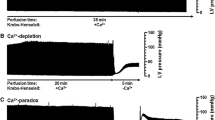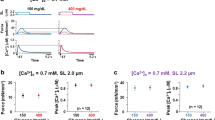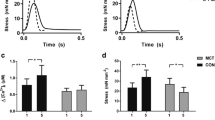Abstract
Disturbances in the cAMP production during β-adrenergic stimulation and alterations of Ca 2+ transport controlling proteins and their regulation in the sarcoplasmic reticulum might be involved in the pathogenesis of the failing human heart. Thus, we investigated the cAMP-mediated phosphorylation of phospholamban, troponin I and C-protein in electrically driven, intact isolated trabeculae carneae from nonfailing and failing (NYHA IV) human hearts in parallel to contractile properties on the same tissue samples. The increase in force of contraction induced by isoproterenol (0.2 μM) or pimobendan (100 μM), a phosphodiesterase inhibitor, was diminished in the failing human hearts compared to nonfailing hearts by 49% and 36%, respectively. Concomitantly the isoproterenol-induced phosphorylation (pmol P/mg homogenate protein) of phospholamban, troponin I and C-protein was reduced from 13.0 ± 2.4 (n = 4), 30.5 ± 1.5 (n = 5) and 11.0 ± 1.3 (n = 5) in the nonfailing heart to 5.2 ±0.6 (n = 13), 14.6 ± 2.2 (n = 16) and 7.1 ± 1.0 (n = 6) in the failing human heart, respectively. Pimobendan changed the phosphorylation state of these proteins similar to isoproterenol. The fact that combined addition of both agents or dibuturyl CAMP (1 mM) alone restored the phosphorylation capacity as observed in the control groups indicates that i) a reduced cAMP generation is related to the reduced phosphorylation of regulatory phosphoproteins located in the sarcoplasmic reticulum and contractile apparatus e.g. phospholamban, troponin I and C-protein, that ii) there is a relationship between protein phosphorylation state and contractile activity and that iii) no changes in the respective content of phosphoproteins are involved in the limitation of cAMP-mediated inotopic activity in the failing human heart. (Mol Cell Biochem 157: 171–179, 1996)
Similar content being viewed by others
References
Bristow MR, Ginsburg R, Minobe W, Cubicciotti RS, Sagemann WS, Luriek K, Billingham ME, Harrison DC, Stinson EB: Decreased catecholamine sensitivity and β-adrenergic receptor density in failing hearts. N Engl J Med 307: 205–211, 1982
Brown L, Lorenz B, Erdmann E: Reduced positive isotropic effects in diseased human ventricularmyocardium. Cardiovasc Res 20: 516–520, 1986
Schmitz W, Scholz H, Erdmann E: Effect of α- and β-adrenergic agonists, phosphodiesterase inhibitors and adenosine on isolated human muscle preparations. Trend Pharmacol Sci 8: 447–450, 1987
Feldman MD, Capelas L, Gwathmey JK: Deficient production of cyclic AMP: pharmacological evidence of an important cause of contractile dysfunction in patients with end-stage heart failure. Circulation 75: 331–339, 1987
Danielsen W, Leyen H, Meyer W, Neumann J, Schmitz W, Scholz H, Starbatty J, Stein B, Doring V, Kalmar P: Basal and isoproterenolstimulated cAMP content in failing versus nonfailing human cardiac preparations. J Cardiovasc Pharmacol 14: 171–173, 1989
von der Leyen H, Neumann J, Nose M, Schmitz W, Scholz H, Starbatty J, Stein B, Wenzlaff H, Doring V, Kalmar P, Haverich A: Mechanism underlying the reduced positive isotropic effects of the phosphodiesterase III inhibitors pimobendan, adibendan and saterinone in failing as compared to nonfailing human cardiac muscle preparations. Naunyn Schmiedeberg's Arch Pharmacol 344: 90–100, 1991
Gwathmey JK, Capelas L, MacKinnon R, Schoen FJ, Feldman MD, Grossman W, Morgan JP: Abnormal intracellular calcium handling in myocardium from patients with end-stage failure. Circ Res 61: 70–76, 1987
Packer M: Abnormalities of diastolic function as a pontential cause of exercise intolerance in chronic heart failure. Circulation 81 (Suppl III): 78–86, 1990
Neumann J, Schmitz W, Scholz H, Meyerinck L, Döring V, Kalmar P: Increase in myocardial Gi-proteins in heart failure. Lancet 11: 936–937, 1989
Feldman AM, Cates AE, Bristow MR, van Dop C: Altered expression of α-subunit of G proteins in failing human hearts. J Mol Cell Cardiol 21: 359–365, 1989
Murphree SS, Jeffrey E, Saffitz MD: Distribution of β-adrenergic receptors in failing human myocardium. Implications for mechanisms of down-regulation. Circulation 79: 1214–1225, 1989
Solaro RJ, Robertson SP, Johnson JD, Holroyde MJ, Potter JD: Troponin-I phosphorylation: A unique regulator of the amounts of calcium required to activate cardiac myofibrils. Cold Spring Harb Conf Cell Prolif 8: 901–911, 1981
Tada M, Katz AM: Phosphorylation of the sarcoplasmic reticulum and sarcolemma. Annu Rev Physiol 44: 401–423, 1982
England PJ: Phosphorylation of cardiac muscle contractile proteins. In: A.J. Drake-Holland and M.I.M Noble (eds). Cardiac Metabolism. John Wiley & Sons, New York, 1983, pp 365–389, 1983
Solaro RJ: Modulation of activation of cardiac myofilaments by beta-adrenergic agonists. In: J.A. Lee, D.G. Allen (eds). Modulation of Cardiac Calcium. Oxford University Press, 1993, pp 160–177
Beuckelmann DJ, Nabauer M, Erdmann E: Intracellular calcium handling in isolated venticular myocytes from patients with terminal heart failure. Circulation 85: 1045–10559, 1992
Zhang R, Zhao J, Mandveno A, Potter J D: Cardiac troponin I phosphorylation increases the rate of cardiac muscle relaxation. Circ Res 76: 1028–1035, 1995
Karczewski P, Bartel S, Krause EG: Differential sensitivity to isoproterenol of phospholamban and troponin I phosphorlyation in isolated rat hearts. Biochem J 266: 115–122, 1990
Scheffold T, Rempis A, Zehelein J, Franz W, Gruning E, Vosberg HP, Barton B, Katus A: Characterisation of the isoprotein composition of the myofilaments of human myocardium. Eur Heart J 14: Suppl 140 (Abstract), 1993
Laemmli UK: Cleavage of structural proteins during the assembly of the head of the bacteriophage T4. Nature 227: 680–685, 1970
Lowry OH, Rosebrough NJ, Farr AL, Randall RJ: Protein measurement with folin phenol reagent. J Biol Chem 265–275, 1951
Haase H, Karczewski P, Beckert R, Krause EG: Phosphorylation of the L-type calcium channel β-subunit is involved in β-adrenergic signal transduction in canine myocardium. FEBS lett 335: 217–222, 1993
Chen TC, Law B, Kondratyuk T, Rossie S: Identification of soluble protein phosphatases that dephosphorylate voltage-sensitive sodium channels in rat brain. J Biol Chem 270(13): 7750–7756, 1995
Towbin H, Staehelin T, Gordon I: Electrophoretic transfer of proteins from polyacrylamide gels to nitrocellulose sheets: Procedure and some applications. Proc Natl Acad Sci 76: 4350–4354, 1979
Ungerer M, Parruti G, Böhm M, Puzicha M, Beblasi A, Erdmann E, Lohse MJ: Expression of β-arrestins and β-adrenergic receptor kinases in the failing human heart. Circ Res 74: 206–213, 1994
Movsesian MA, Karimi M, Green K, Jones LR: Ca2+-transporting ATPase, phospholamban, and calsequestrin levels in nonfailing and failing human myocardium. Circulation 90: 653–657, 1994
Schwinger RHG, Bohm M, Schmidt U, Karczewski P, Bavendiek U, Flesch M, Krause EG, Erdmann E: Unchanged protein levels of SERCAII and phospholamban but reduced Ca2+-uptake and Ca2+-ATPase-activity of cardiac sarcoplasmic reticulum from patients with dilated cardiomyopathy compared to nonfailing patients. Circulation 92: 3220–3228, 1995
Hasenfuss G, Meyer M, Schillinger W, Pieske B, Scheffler A, Holubarsch C, Reinecke H: Expression of sarcoplasmic reticulum proteins in failing and nonfailing human myocardium. Circulation 90: 1160, 1994
Darvish A, Moravec CS: Decreased sarcoplasmic reticulum calcium content in the failing human heart is associated with a decrease in Ca2+ ATPase and phospholamban proteins. Circulation 90: 1161, 1994
Sasse S, Brand NJ, Kyprianou P, Dhoot GK, Wade R, Arai M, Periasamy M, Yacoub MH, Barton PJR: Troponin I gene expression during human cardiac development and in end-stage heart failure. Circ Res 72: 932–938, 1993
Morano I, Hadicke K, Grom S, Koch A, Schwinger RHG, Bohm M, Bartel S, Erdmann E, Krause EG: Titin, myosin light chains and C-protein in developing and failing human heart. J Mol Cell Cardiol 26: 361–368, 1994
Bohm M, Reiger B, Schwinger RHG, Erdmann E: cAMP concentrations, cAMP-dependent protein kinase activity, and phospholamban in non-failing and failing myocardium. Cardiovasc Res 28: 1713–1719, 1994
Movsesian MA, Colyer J, Wang JH, Krall J: Phospholamban-mediated stimulation of Ca-+ uptake in sarcoplasmic reticulum from normal and failing hearts. J Clin Invest 85: 1698–1702, 1990
Luo W, Grupp IL, Harrer J, Ponniah S, Grupp G, Duffy JJ, Doetschman T, Kranias EG: Targeted ablation of the phospholamban gene is associated with markedly enhanced myocardial contractility and loss of β-agonist stimulation. Circ Res 75: 401–409, 1994
Hofmann PA, Hartzell HC, Moss RL: Alterations in Ca2+-sensitive tension due to partial extraction of C-protein from rat skinned cardiac myocytes and rabbit skeletal muscle fibers. J Gen Physiol 97: 1141–1163, 1991
Palmer CJ, Scott BT, Jones LR: Purification and complete sequence determination of the major plasma membrane substrate for cAMP-dependent protein kinase and protein kinase C in myocardium. J Biol Chem 266: 11126–11130, 1991
Yoshida A, Takahasi M, Imagawa T, Shigekawa M, Takisawa H, Nakamura T: Phosphorylation of ryanodine receptors in rat myocytes during beta-adrenergic stimulation J Biochem (Tokyo) 111: 186–190, 1992
Author information
Authors and Affiliations
Rights and permissions
About this article
Cite this article
Bartel, S., Stein, B., Eschenhagen, T. et al. Protein phosphorylation in isolated trabeculae from nonfailing and failing human hearts. Mol Cell Biochem 157, 171–179 (1996). https://doi.org/10.1007/BF00227896
Issue Date:
DOI: https://doi.org/10.1007/BF00227896




